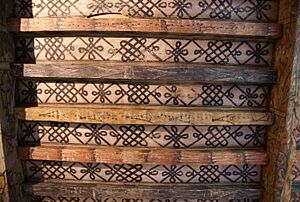Huntingtower Castle facts for kids
Huntingtower Castle, once called Ruthven Castle, is a cool old castle in central Scotland. It's near the village of Huntingtower, not far from the city of Perth. This castle is famous for its interesting history and some local ghost stories!
Contents
A Castle with a Long Story
Huntingtower Castle has been around for a very long time. It was built at least by the 1300s. One of its early owners was Alexander Stewart, also known as the "Wolf of Badenoch." He was a powerful and sometimes troublesome lord who died there in 1394.
Later, in the 1400s, the Ruthven family took over the castle. For hundreds of years, it was known as 'Ruthven Castle' or the 'Place of Ruthven'. The name changed to Huntingtower after the Ruthven family lost their lands in 1600. This happened because of a big event called the Gowrie Conspiracy.
Royal Visits and a Kidnapping
Many important people visited Huntingtower Castle. Mary, Queen of Scots, visited twice in 1565.
In 1582, something very dramatic happened at the castle. The 1st Earl of Gowrie, William Ruthven, and his friends took the young King James VI. King James was the son of Mary, Queen of Scots. This event is known as the 'Raid of Ruthven'. The king was held prisoner for about ten months. The people who took him hoped to gain power by controlling the king. King James eventually escaped in 1583.
King James VI later forgave Gowrie. He even came back for a special dinner at the castle. But Gowrie tried to go against the king again. Because of this, Gowrie was executed, and his castle was taken by the crown.
The Castle's New Name
In 1586, the Ruthven family got their castle back. King James visited again in 1587. However, in 1600, two of Gowrie's brothers were accused of trying to kidnap King James. They were killed in their home in Perth. This time, the king was very strict. He took all their lands and said the Ruthven name could no longer be used for titles or lands. That's when Ruthven Castle was officially renamed Huntingtower.
The castle stayed with the crown for a while. King James VI even wrote letters from "Huntingtower" in 1601. Later, in 1643, the castle was given to the Murray family. They lived there for many years.
Over time, the castle became less used as a home. After 1767, it was mostly used by farm workers. Today, Huntingtower Castle is looked after by Historic Scotland. You can visit it all year round and even have weddings there!
How the Castle Was Built
Huntingtower Castle is made up of two main towers. The first tower, now called the 'Eastern Tower', was built as a gatehouse. It has three floors and an attic.
Around the late 1400s, a second tower, the 'Western Tower', was built next to it. There was a gap of about three meters between the two towers. They were connected by a wooden bridge. This design was for defense. If one tower was attacked, people could escape to the other and pull up the bridge. This made it harder for attackers to follow.
Later, in the late 1600s, the space between the two towers was filled in. This created the castle we see today. At the same time, more and bigger windows were added, especially in the Western Tower.
Amazing Painted Ceilings
One of the most special things at Huntingtower Castle is the old paintings. On the first floor of the Eastern Tower, you can see paintings from the early 1500s. There are wall paintings with flowers, animals, and even Bible scenes.
The wooden ceiling in this tower has a beautiful and mostly complete design. It shows strange animals, including a "green man" figure. There are also cool knot-like patterns. This painted ceiling is thought to be the oldest of its kind still surviving in Scotland. It's a real treasure!
Ghost Stories and Legends
Huntingtower Castle is known for its spooky tales!
Lady Greensleeves
The castle is said to be haunted by "Lady Greensleeves." She was a young woman named Dorothea, whose father was the 1st Earl of Gowrie. The story says she was in love with a servant at the castle. They would meet secretly at night in the eastern tower.
One night, Dorothea's mother, the Countess, found out. She started walking across the bridge from her family's tower to the servants' tower to catch them. Dorothea heard her mother coming. She couldn't go back across the bridge. So, she bravely jumped from the roof of the eastern tower to the battlements of the western tower! This was a huge jump, several meters across. She landed safely and quickly got back into bed before her mother found her. The next day, Dorothea and her lover ran away together.
People have reported seeing a tall young woman in a green silk dress around Huntingtower. She is usually seen at dusk, but sometimes even during the day. Her appearance is said to be a sign of bad luck or a disaster to come. One story tells of a traveler who saw Lady Greensleeves in the 1930s. The next day, he drowned when he fell from a ferry.
St Conval's Well
Another legend is about St Conval's Well, which is near the castle. The water from this well is believed to have healing powers. But there's a rule: if you go to get the water, you must not speak a single word on your way there or back. If you do, the water loses its magic! People who get water from the well are also supposed to leave a small gift, like a coin, at the well. The well is still there today and has clear water.
Notable People Connected to the Castle
George Turnbull, a famous civil engineer, grew up nearby. He was the Chief Engineer for building the first railway from Calcutta in India. This railway was very long, stretching over 541 miles!



